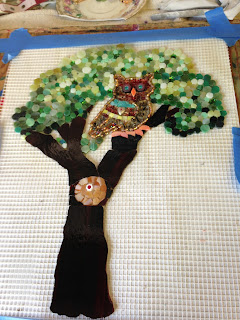NO Days Mosaic Adhesive can be used on three dimensional objects with a bit of patience and creativity. It’s great for working on several pieces at once, as you can heat set one object and move on to the next while waiting for the adhesive to cool.
For this demonstration, we’ll be using NO Days Mosaic Adhesive with a clay pot, a glass votive, and a ceramic ornament, beginning with the clay pot...
The first thing we're going to do is use our scissors to cut a strip of adhesive off of the sheet. I usually use one strip to start out. I take my pieces and layer the pieces onto my strip. I have my wedgies holding the pot so that I have a level surface
The wedgies are nice because they’re made from a non-slip, heat resistant foam, holding your project securely, and leaving your hands free. Your local stained glass studio should be able to order them for you. Once you’ve got your first row of tiles laid, it’s time to heat set the adhesive.
We're going to heat the glass and wait for the terracotta to warm up. you'll be able to see the adhesive grab onto the terracotta, it almost seeps into the terracotta when the terracotta warms up. it kind of looks like the terracotta is getting wet under the adhesive.
NO Days Mosaic Adhesive changes from a solid to a liquid at 160 degrees Fahrenheit (71 degrees C). When the adhesive is heated, it liquifies and grabs onto the pot and the glass. You can feel the tiles glide along the surface of the pot. If the tiles don’t glide, then the adhesive has not been heated enough.
So we're going to heat this up a little bit more, I'm going to heat underneath it. I'm not really worried about the terracotta heating up at this point. the terracotta will not break or thermal shock. It's porous so it grabs the adhesive nicely. The trick is to let everything to completely cool before you move on to your next row. in the past I've taken a piece of mt
Then, putting a piece of masking tape...over this to keep it from sliding so if it does soften up when your heating next row it won't slide anywhere. no were going to do our next row, and for this one I'm going to cut a little bigger piece of adhesive and we're going to put in a little larger section now that we have our first section applied.
As you’re heating the next section the tiles will begin to slide, and when they do, stop heating. Move them into place with a tool if you need, and in a few seconds they will stop sliding and begin to cool. Continue to build the rest of the way around the pot in the same manner, working on sections until you reach the first section. You can grout the pot as soon as the adhesive cools.
Using the same technique and building in strips, it’s possible to mosaic a variety of surfaces with NO Days Mosaic Adhesive...next we’re using a glass votive candle holder with glass globs...
were going to take some of our globs and set them on mixing the colors up. were going to heat the piece up. some of the pieces of glass that you find will have thicker areas around the base...thermal shock and thick bottoms, votive is small and thin, uniform so less chance for thermal shock.
For our next project, we’ll be building on a sphere, a small ceramic ornament. This same technique can be applied at a larger scale, for example, on a bowling ball...
place adhesive on surface, preheat to shrink the adhesive onto the surface. Place globs few at a time on the surface. heat holding gun a little higher to prevent the pieces being blow away by air you can see the adhesive melting, heating glass globs and ornaments to make sure the adhesive fully adheres, you can feel it slide a little bit when it adheres.
For more ideas and instructional videos for using NO Days Mosaic Adhesive, visit http://Streuter.com.
For ordering information or help with questions, contact: info@streuter.com.
Content:
-building a mosaic on a round surface
-tips for keeping the pieces in place
-glass on glass considerations






